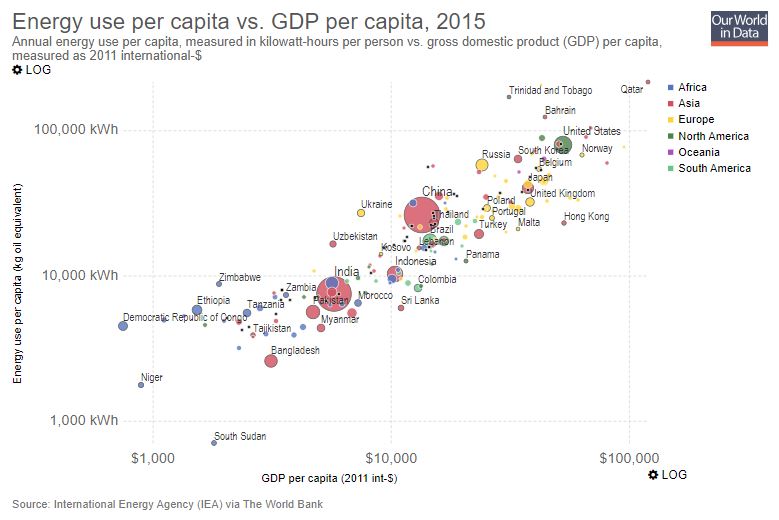Written by Ryan McGuine //
Energy and economic development significantly affect one another. Exactly how they do so, though, is far from straightforward and depends on a dizzying web of interrelated complex systems. As such, this post will not provide the reader with a definitive relationship between the two, but rather will provide an overview of topics regarding the relationship.
Energy is a crucial input for economic development, since nearly every single good and service that contributes to a country’s gross domestic product (GDP) requires some form of energy. Roadside food vendors in India use propane to make flavorful dishes, the rail for Ethiopia’s high-speed train connecting Addis Ababa to Djibouti’s port is constructed out of steel that was made in China using coal coke and shipped across the ocean using residual fuel oil, and Google powers its massive server farms in America with electricity that it has purchased from companies harnessing wind and solar energy.
It is well-documented that over time, the rate at which societies consume energy increases as they achieve higher levels of development, since the total amount of economic activity increases. A graph of global energy consumption over the very long run exhibits a similar shape as that of global GDP per capita over time — near-zero growth for millennia, followed by comparatively astounding growth for two centuries — and one could essentially rephrase the second of the New Kaldor Facts in terms of energy consumption. There is a clear general trend of higher energy consumption being associated with higher incomes, as well as lower shares of population in extreme poverty, demonstrated by the graphs below.


An important distinction must be made between energy consumption and energy access. Much international attention gets directed towards expanding energy access, often in the form of solar panels for rural homes and small businesses. Even venture capital-backed companies have joined aid organizations in the fight against rural energy poverty, but these systems usually replace more primitive alternatives without improving development metrics like household incomes or child test scores. Even if it were possible to provide universal access to modern energy technology, that alone is unlikely to dramatically improve well-being, since gaining access to distributed energy sources can generate some productivity gains, but the effect tends to be small. For context, the UN estimates that the number of people without electricity access fell from 1.2 billion to 789m between 2010-2018, but the number of people without access to “reasonably reliable” electricity access is close to 3.5 billion.
As such, it turns out that energy consumption is more closely correlated with higher levels of well-being than energy access. Residential applications can greatly expand capability sets — lighting allows children to study after dark without worrying about accidentally spilling kerosene and getting burned, and using electric stoves instead of open fires for cooking reduces cases of lung and heart disease in women. However, large-scale, productive enterprises like agricultural processing facilities and manufacturing factories create an electrical load large enough to necessitate cost-effective power generation and distribution, while simultaneously creating incomes large enough to raise energy consumption.
It is not clear whether the arrow of causality necessarily points from increased energy consumption towards economic growth. Energy consumption is endogenous to a given economy — that is, it is constantly changing in response to the prevailing economic conditions. As such, economic growth also enables increased energy consumption. If the incomes of a large portion of a country’s population increase due to sustained economic growth, the population can afford to spend more money on energy.
In addition to increasing energy consumption, another pattern observed with higher levels of development is a transition toward primary energy sources with higher power densities. Prior to 1800, the vast majority of energy consumed was traditional biomass like wood, animal dung, and other organic matter. By 1900, coal made up about half of all energy consumed, petroleum products took off as a transportation and heating source around the same time, and nuclear energy saw a rapid expansion in the 1960s. Today’s shift from fossil fuels to renewable energy is a departure from the pattern of increasing power density in energy sources.

The energy intensity (unit energy per dollar GDP) of economies tends to increase with income level, then decrease. By 1985 it took the US economy 37% less crude oil to produce a dollar of GDP than it did in 1970, and by 2014 it required 62% less than in 1970. Energy intensity in the USA reached its peak before 1920, China’s peaked around 1980, and India’s peaked near 2010. This occurs in part because of the adoption of efficiency-boosting technological improvements, and the tendency of industry to play a decreasing role in a country’s growth as incomes rise.
Finally, fossil fuel combustion, which still accounts for the largest share of energy inputs for all industries, results in both local ambient air pollution and global ambient air pollution. Since energy consumption increases with economic growth, countries typically see rapid increases in air pollution as they strive to meet the energy demands of their economy. Gradually, local ambient air pollution tends to decline due to the combined effects of structural change toward services, better embedded technology, and improved regulation. Global ambient air pollution is more difficult to mitigate, and the same pattern of declining emissions is nonexistent. Below are plots of SO2 (a local pollutant) and CO2 (a global pollutant) over time.


